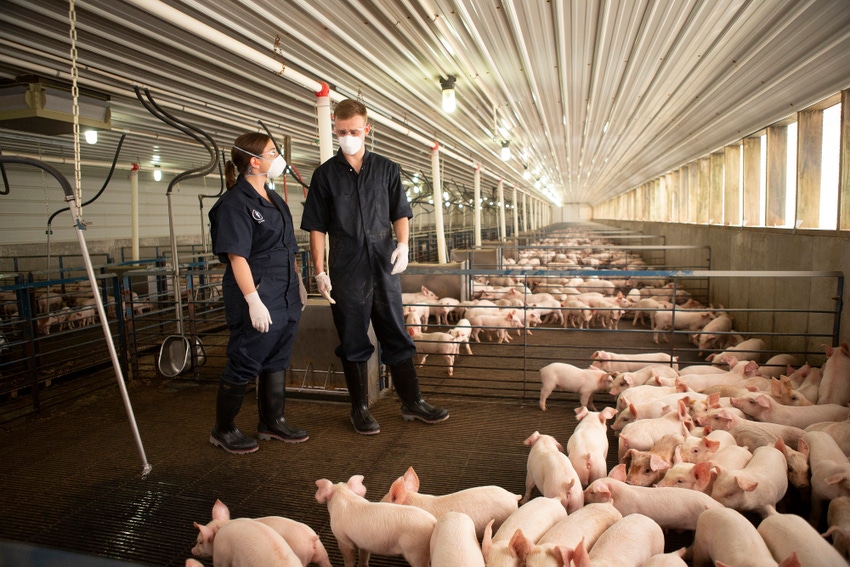Veterinarians can be involved in training as a trusted advocate for both pig care and healthcare.
March 31, 2021

Veterinarians are often a trusted point of influence in on-farm operations. The invitation to evaluate pig care and pig health is only the start of the veterinary-client-patient relationship. Our team in Carthage has been a part of a new trend that emerged within our client’s worker training program this past year. We have seen a dramatic shift in the reduction of worker safety issues and worker injuries.
Worker safety is much like biosecurity in that everyone wants to be seen as “following the rules,” yet no one wants to be inconvenienced. The veterinarian can intervene when trusted examples are needed for safety and training. Our management service company changed the process of on-boarding new staff people in late 2019. New hired employees all begin their first 10 days of employment with an in-office introduction followed by on-farm instruction, all at the same single farm close to the home office. We have a van shuttle the new staff to the farm, and we have farm staff members and management service staff guide them through the entire process. They remain at the on-boarding farm for one full week before going to the farm where they will work.
Some new staff decide within the first few days that the work is not for them. It is much better to have those discussions before several weeks of wandering a maze of hallways or farrowing rooms. Some also decide they want to make this a career and ask for volumes of information to help them grow personally. We find more folks fall into the second group wanting to do better.
Veterinarians can be involved in this process as the trusted advocate for both pig care and healthcare. Vets are familiar with explaining not only “how” it is to be done, but “why” certain processes are important. Leading by example during the initial on farm introduction brings a whole new perspective to "why" and includes not only care for the pigs, but also care for one another while on farm.
What can you do about this responsibility to reduce worker injury and advocate for worker safety?
Learn the rules. If sort boards and eyeglasses are part of the company protocol, learn it.
Learn the risks. If a procedure on farm is high risk and prone to injury, learn why.
Teach safety. Veterinarians and production teams work best when they work together.
Create your own additional rule, leading by example.
The exciting results of this new method of on-boarding have proven in 2020 to be successful in both staff retention and worker safety. Our management service on-boarded 359 people in 2020 with group sizes of not more than 10 people in any given week. They did this all year long and continue to bring on new people through a structured teaching process. Even with COVID restrictions and attendance issues, the teams were able to provide a safe learning environment and share valuable worker behaviors to protect the team members and provide better pig care. PQA and We Care principles are core to the education process.
The proof of this method of training is in the results. In 2019, the management service company had a total of 259 reported injuries, and in 2020, that number dropped to 184. The same number of farms and farm staff were included with a significant drop in both reported injuries and lost work days (or worker compensation claims). The initial 90 days of employment were the most exciting.
In 2018, the same farms experienced 74 injuries to staff people with under 90 days of employment. The number of injuries in the first 90 days of employment for the whole year of 2020 dropped to only 18.
For the previous 5 years, the first 90 days had been the most common or highest population to report injuries. With proper training, this population of staff people are now under several other groups and yet are still one of the largest employee groups on any farm.
In swine farm production, we are likely to continue working with people who may have never worked with animals before. Moving sows, giving shots and handling heavy power equipment will always be training opportunities. Veterinarians may be called on to support training new people on farm visits. At the very least, the veterinarian should know and respect the safety rules for the client.
There is a portion of the workforce today who do not remain at the same job for extended periods of time. Many industries have adjusted their staff on-boarding to focus on early job introduction and safety. Veterinarians can serve as a valuable voice in teaching the “why” and “how” for their clients.
Results speak for themselves in the Carthage System. The production teams created the program and deserve all the credit for success. Today, they continue to serve the farms with structured on-boarding, farm safety committee materials, and morning safety briefings. The shareholders of the farms are happy to see the workforce safety results.
The next step is to create a learning environment where the veterinarian can reinforce the success while joining in the conversation in the barn. The veterinarian will be well received when they lead by example.
Sources: Bill Hollis, DVM, Carthage Veterinary Service, who are solely responsible for the information provided, and wholly own the information. Informa Business Media and all its subsidiaries are not responsible for any of the content contained in this information asset.
You May Also Like



